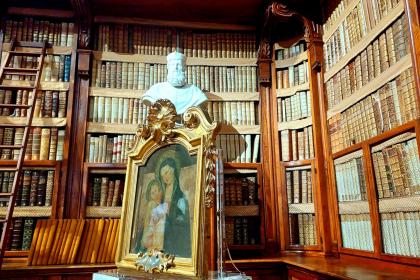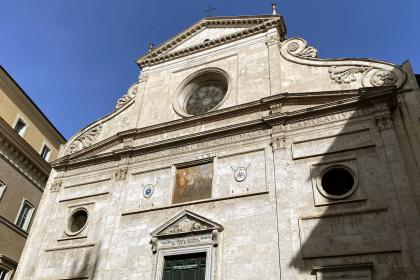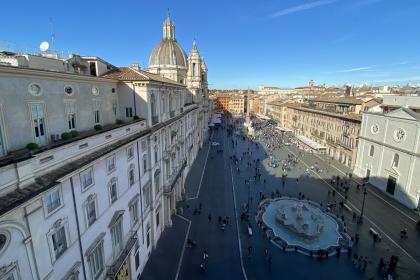
Almost 3,000 Latin, Greek and Oriental manuscripts, one thousand incunabula (including the first book with movable type printed in Italy, Cicero’s “De Oratore”), 20,000 sixteenth-century editions, 10,000 engravings and maps, precious for their antiquity and artistic value, as well as documents, books that escaped the stake even if considered heretical by the Church, works on Augustinian studies, texts on Italian literature and theatre, rare editions and ancient periodicals that are still being increased today thanks to purchases and donations. A total of about 200,000 volumes are preserved in the high wooden shelves of the Angelica Library, in an evocative scenario suspended in time that has also been used as the setting for famous films, from Vittorio de Sica’s The Garden of the Finzi-Continis to Ron Howard’s Angels and Demons.
Located in a building next to the Church of Sant’Agostino, a few steps from Piazza Navona, the Angelica Library is one of the oldest public libraries in the world, a record it shares with the Ambrosiana Library in Milan and the Bodleian Library in Oxford. Its first historical records date back to the 14th century, but it was the initiative of the Augustinian bishop Angelo Rocca, after whom it was named, that radically changed its character. Passionate collector of fine editions and head of the Vatican Printing House, in 1604 the bishop entrusted his book collection of about 20,000 volumes to the friars of the monastery of St Augustine, giving the library a suitable home, endowing it with its own revenues and stipulating that it should be open to all, without limits of status or census.
In 1661, the library was enriched with the printed texts bequeathed by Lukas Holste, the custodian of the Vatican Library, and in 1762 with the enormous collection of Cardinal Domenico Passionei, which included works on the thought of St. Augustine and the work of the Augustinian Order, as well as texts on the religious controversies of the time. Thanks to a special papal authorization, the library’s holdings also included books that had been put on the index by the Church because they were “dangerously” close to the Protestant Reformation. Essays, articles, literary texts, volumes on astrology, history, science or philosophy, were judged with the utmost severity but preserved, marked with certain special signs such as an arrow on the spine or inside.
With a collection that had grown out of all proportion, in the last quarter of the 18th century the friars entrusted the multifaceted architect, painter and engineer Luigi Vanvitelli with the task of renovating the library. The current hall was completed in 1765: called the Vanvitelli’s “vase” because of its shape, it is a unique room imagined to gather around the scholars all the culture of the time, with wooden shelves surrounding the entire perimeter up to the ceiling to complete the dramatic effect. After the Unification of Italy, the library was acquired by the new Italian State, but its holdings continued to grow, for example with part of the Princes Massimo collection, a curious collection of opera librettos from the 18th and 19th centuries, and the autographs of the Roman poet Luigi Zanazzo. Since 1940, the Angelica has also been the seat of the Literary Academy of Arcadia (founded in 1690 by a number of men of letters), whose library holdings it preserves.
Seven different point of views to read Rome: the historical libraries

The history of Rome seen through its libraries
The Basilica of Sant’Agostino in Campo Marzio

 Condividi
Condividi
Navona Square

 Condividi
Condividi
The most iconic square of Baroque Rome
Information
For opening times and visiting condition, please check the contacts.
 Condividi
Condividi
Location
To find out about all accessibility services, visit the Rome accessible section.











































